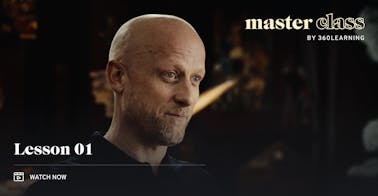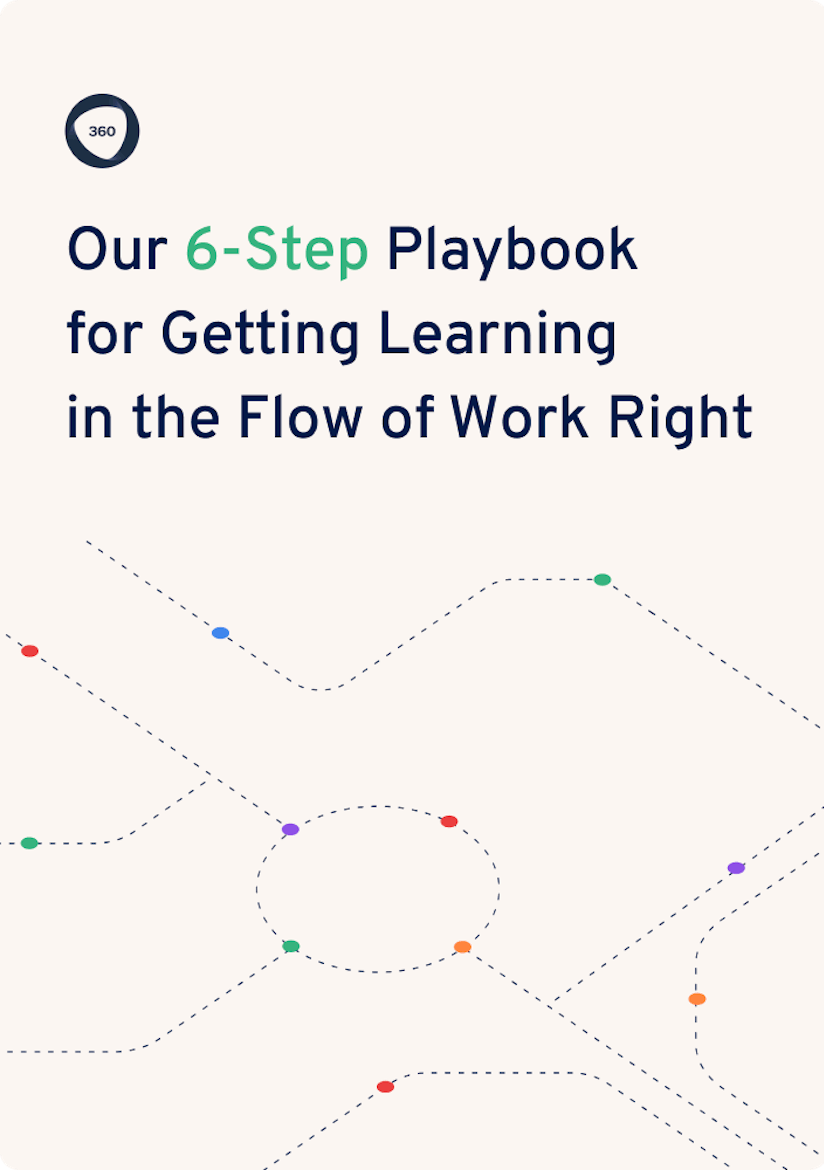
As humans, we have a massive capacity for sustained attention, but we’re still pretty busy, especially amid an economic downturn.
So, as an L&D leader, where can you find inspiration and fresh ideas to tweak your learning and development strategy on the go? And how can you start exploring your organization to collaborate with other departments to demonstrate greater impact?
In this podcast episode, I speak with Michelle Parry-Slater about her book, The L&D Handbook, aimed at offering actionable steps and resources for L&D experts and explore what we can do to make a greater impact on performance.
Read on to hear what inspired Michelle to write an L&D handbook you can ‘dip into,’ how you can leverage her practical steps to design digital learning that works, and three frameworks you can start to adapt today.
So, what compelled Michelle to write a learning and development handbook?
A personal journey to inspire solo L&D professionals
Michelle started writing her book for someone like herself at the time: a solo learning and development professional in their organization.
As a global head of learning, she joined podcasts and built a personal network to get inspiration from other people and hear how they try out new ideas. “I wanted to share my journey to help others feel that they could go on their own journey, expand their thinking, and try new stuff,” Michelle says.
“However, it isn't a step-by-step guide,” she explains, “but a dip in and out handbook. It is an encouragement to try new things with a lot of lists, a lot of questions, and a lot of reflections.”
Michelle explains that each of the 14 chapters starts with a short read, meaning you can get through the book in a couple of hours. “But if you're inspired or want to know more, there's the long read in each chapter as well,” she says.
“And then every chapter's got a case study. I give a few thoughts on each, but I encourage you to have your own thoughts. It's great to hear stories, but only if we can always get those stories back to our context.”
Michelle structured the book this way because she finds that in L&D, we jump into learning solutions without having the evidence we need to support them and end up with a training solution that doesn’t land with learners or meet them at their point of need.
In L&D, we jump into learning solutions without having the evidence we need to support them and end up with a training solution that doesn’t land with learners or meet them at their point of need.
The book's first part focuses on encouraging people to explore their own organization to understand their context, their stakeholders, the company’s strategy, and the language of the business they work in.
“In the middle, I offer a few frameworks to give people some structure to the way that they might want to approach L&D, while the latter end of the book is strategies to make all of the things we've talked about earlier in the book come to life and work,” Michelle says.

Practical, hands-on learning in 6 simple steps
By providing your contact info, you agree to receive communications from 360Learning. You can opt-out at any time. For details, refer to our Privacy Policy.
Unlocking true L&D value
A key theme in the handbook is how L&D doesn’t offer great value in learning solutions alone but rather in embedding and understanding learning within their organization.
“So, it’s about asking what is the culture of learning within your organization? What environments are you setting up for people to learn in your organization? Are permissions in place for people to learn? Do people have learning conversations?”
“Over the last three years,” Michelle says, “we've seen that people have been able to move quickly because they've had to. And so, there's no going back now or excuses that it won't work. We've all had the opportunity to demonstrate and realize that we can shift quickly.”
“Over the last three years, we've seen that people have been able to move quickly because they've had to. And so, there's no going back now or excuses that it won't work. We've all had the opportunity to demonstrate and realize that we can shift quickly.
As a big believer in live online learning, Michelle agrees that sometimes getting people together physically does work. Still, she advocates for it being what it is, mainly for networking. “But the knowledge transfer can be done digitally, and so I think the blend is one of the biggest shifts that is not going to go away,” she says.
And I agree with Michelle. If you’re familiar with the podcast, you’ll know that I’m not a big fan of using the classroom as the first step in a learning solution just because it is expected by stakeholders rather than because it works.
Too often in learning and development, we get seduced by the latest fad in content delivery that promises to address our notoriously poor engagement problem. We get lost in chasing engagement when we should be leveraging solutions that work.
So, what practical steps does Michelle see L&D needing to take to rise above the noise of the next ‘mode de jour’ and leverage digital solutions that work?
Related: L&D Master Class Lesson 5: How to Prove Your Impact as a Strategic Business Partner
Identifying stakeholder needs and solving real problems
L&D needs to understand what our stakeholders are interested in and what problems we really need to solve.
“If we're asking the wrong questions, such as what do you need to learn?” she explains, “That’s a tough question for anybody to answer. Whereas if you ask what the barriers to success are in your department or your work, people can talk about that until the cows come home.”
“So, that's where we need to dig. We need to gather the evidence within our organization as to what they need and to stop asking the wrong questions,” Michelle says.
If we're asking the wrong questions, such as what do you need to learn, that’s a tough question for anybody to answer. Whereas if you ask what the barriers to success are in your department or your work, people can talk about that until the cows come home.
More and more L&D thought leaders are pivoting to a performance-orientated approach. For example, Sebastian Tindall, on Michelle Ockers’ Learning Uncut podcast, said that if you gather the evidence of the people you seek to influence, you can be laser-focused on the context in which they cannot perform.
Learners don’t want something that takes them away from work for a long time. They want a solution that helps them do what they are expected to do to get the benefits of completing a task.
And in Michelle’s experience, it is about identifying the right learning solution for the right problem. “One of the underutilized things, as I demonstrate in the book, is using checklists. People just want to know how to do the task. They don’t want to be shown a video and then take notes on how to do the task.”
3 L&D frameworks that leverage departmental collaboration
In her book, Michelle recommends three frameworks that encourage L&D to interact and collaborate with other departments.
1. The 3Rs for developing learning solutions
The 3Rs for developing learning solutions are required, resourced, and referred.
“The whole idea with this framework is that sometimes we have to do the compliance stuff, what is required,” Michelle explains. “It’s a tick box exercise, and we've got to just send the training out to everybody. But the reality is that it's not where people learn, so we also need to be aware of the resources around people.”
“Now, for L&D, we could provide some of those resources or encourage others to provide them, which is where we get that referral. The opportunity is that we move away from formal learning and embrace social and digital learning.”
2. ICE for managing organizational information
The second framework is ICE: information, communication, and education—the best framework for managing information.
“Our remit is the education piece: what can we teach?” she says. “But internal communications has a role to play too. Sometimes information is owned within the organization. So, if your CEO wants to change strategy, that is not our information to own, but it is our information to educate people on how that impacts the rest of the organization.”
“We've got to work symbiotically with comms. We can't teach one thing while they're saying another.”
We've got to work symbiotically with comms. We can't teach one thing while they're saying another.
3. EPC for building a true learning culture
The third framework is environment, permission, and culture, which Michelle leverages to build a true learning culture–something L&D should address more.
“I'm not talking about sending people on courses every year,” she explains. “I mean when we talk about what we learned from working with that customer or what we learned this week in team meetings.”
When Michelle talks about a true learning culture, she means peer networks and communities of practice. “But to get there, we need to think about what environments we put people in to learn,” she says.
For example, companies may give employees a smartphone, but do they also provide express permission to use that device for work? They should be encouraged to use their mobile phone to access the LMS when they need to learn.
“They have these skills at home,” Michelle says. “Nobody is asking permission to go on YouTube to learn how to play a musical instrument. They're doing that because they're motivated.”
“So, we need to be explicit about our and the organization's expectations around learning and development and how that feeds into the culture,” she says.
Related: 7 Ways to Build a Learning Culture that Extends Beyond Training Programs
Is it a great time to be in L&D?
Michelle finds that an economic downturn can be the best time to be in L&D.
“Often, what happens is the finance guys are looking down the spreadsheet asking, ‘Where can we cut some budget? Where can we cut some money?’ And often it's our heads on the chopping block because we don't add enough value,” she explains.
“But we are fundamental in an economic downturn because what do you need when things aren’t great? You need innovation. You need to stay ahead of your competition. You need to be creative in your thinking to stay competitive and get more out of less,” says Michelle.
We are fundamental in an economic downturn because what do you need when things aren’t great? You need innovation. You need to stay ahead of your competition. You need to be creative in your thinking to stay competitive and get more out of less.
Suppose you are not investing in your people, keeping their motivation or creativity high, or encouraging them with the permission to innovate, practice, trial, and fail fast and learn from that failure. In that case, Michelle says your business is going backward because everyone who develops their people stays ahead of the competition.
“So yes, this is a great time to be in L&D, but it's also why we have to constantly be talking about the value we bring,” she says.
Thanks to Michelle for sharing her insights and experience with us! Keen to learn more from L&D experts? Check out our episode with Navid Nazemian on how learning and development can impact C-suite attrition rates or with Donald Clark about the future of corporate learning and the transformative potential of generative AI.
Want more peer insights on transforming workplace learning? Sign up to become a member of the L&D Collective, and check out our other #CLOConnect interviews with top L&D leaders on driving growth and scaling culture through Collaborative Learning. Or you can subscribe (below 👇) to our weekly newsletter to receive our latest posts directly in your inbox.





